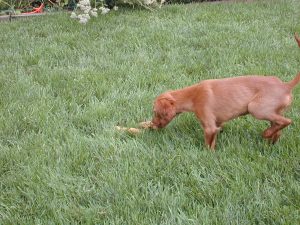 While dogs can ingest most anything, eating rocks, socks, or feces seem to be the Big Three that prompt calls to us. Dogs may also gulp down items they’ve taken from the trash when owners rush to take things away from them or try to pry something out of the dog’s mouth.
While dogs can ingest most anything, eating rocks, socks, or feces seem to be the Big Three that prompt calls to us. Dogs may also gulp down items they’ve taken from the trash when owners rush to take things away from them or try to pry something out of the dog’s mouth.
Some items that your dog ingests can create life-threatening intestinal blockages, so your dog’s life may depend on stopping this behavior. The technical term for this behavior is pica – eating things that aren’t food.
Eating feces is called coprophagia. Eating non-food objects is called pica.
Dogs are prone to eating both their own and other animal’s feces, but we’ve never known cats to do this. Coprophagy is often more bothersome to people than it is to dogs. People become annoyed by feces eating when it causes the dog to vomit, creates bad breath, or because the behavior just seems disgusting.
The simplest intervention is to keep your yard and house picked up. Clean up feces daily from the yard. If your dog likes to eat socks, don’t leave socks lying around. If you can’t keep your pet away from the items, make the objects taste bad using any number of commercially available products until you find one your dog doesn’t like the taste of
Some experts believe that prying and pulling items out of dogs’ mouth when they have something they shouldn’t is one cause of pica. Avoid doing this and instead teach your dog to “give” or “drop” what’s in his mouth when you ask him to. There are many good videos available online teaching you how to do this using positive reinforcement.
Some over the counter products are sometimes effective in stopping coprophagia. These products work some of the time with some dogs, but are not consistent in their effects. Other products are available only through your veterinarian so you should ask which ones your veterinarian believes would be best for your dog.
If these general suggestions aren’t working, and especially if the pica is causing life-threatening blockages, you should seek professional help, preferably from a certified applied or veterinary behaviorist. Read our Guidelines for Choosing a Behavior Consultant. .